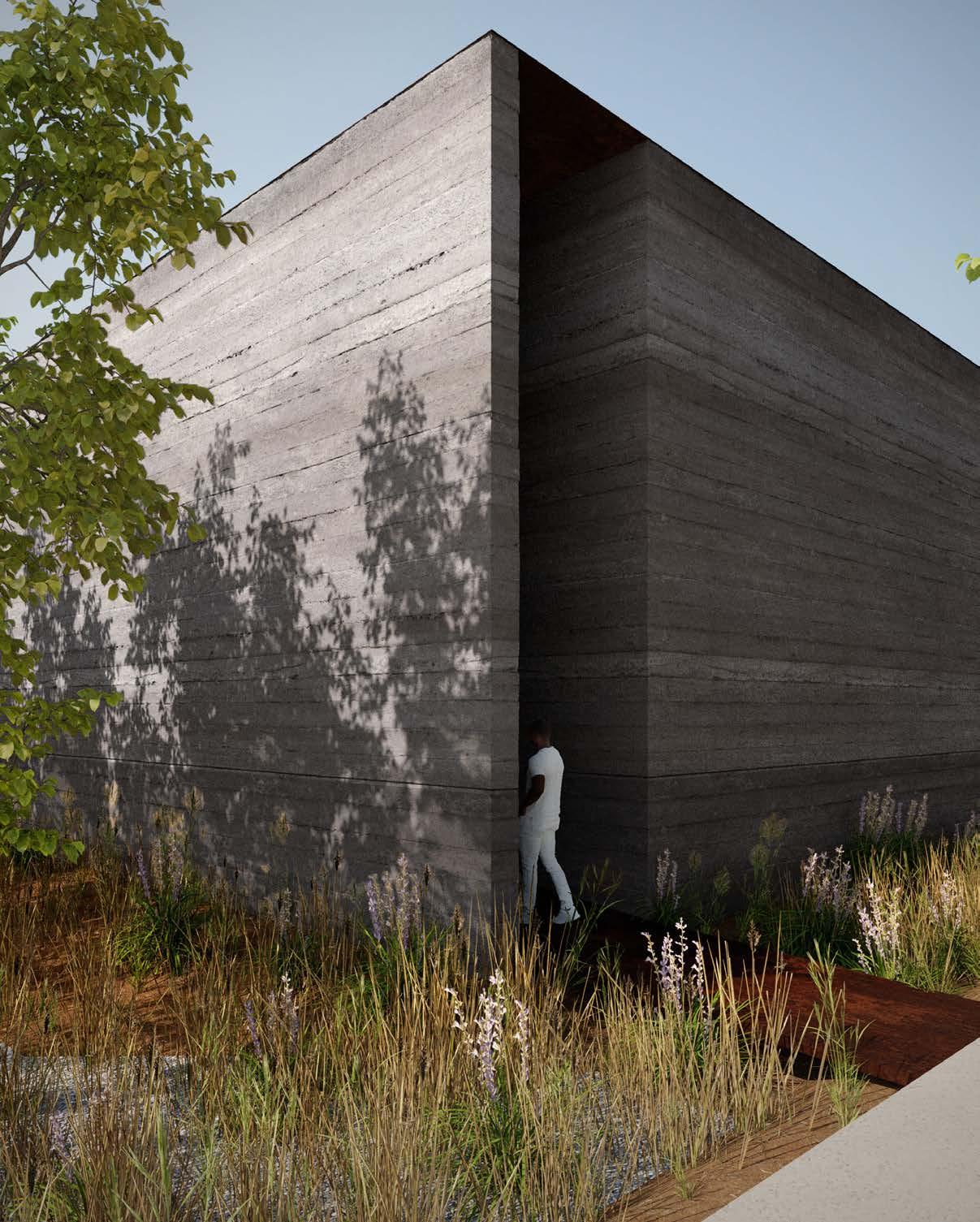PORTFOLIO
Gabriela Calzada Lozada





Professional Funeral Services (PFS) is a local funerary services company operating in New Orleans, LA, looking to expand it’s operations to a new location. The project explores issues of death, grief, and celebration of life within the rich cultural funerary traditions of New Orleans. The program is organized into five separate pavillions, and utilizes the landscape as a connector as well as extension of the spaces within. The project priritizes the use of innovative building materials, community engagement, and longterm sustainable operation practices.





Headquarters Level 2
Headquarters Level 1





Trahan Architects
June 2021 - present
Designer - Stadium Bowl Seating, Administrative offices, L000 Team Store

The Caesars Superdome is a 72,000 seat venue that serves as the home of the NFL New Orleans Saints. Trahan Architects is responsible for all design efforts required to meet the Louisiana Stadium and Exposition District’s expectations for a $450 Million Master Plan addressing Capital Improvements that focus on overall facility and team related revenue enhancement opportunities, as well as fan experience and amenities. Trahan Architects is currently engaged in ‘Phase 3’ of a multi-phase interior renovation of this historical building which consists of the interior renovation of approximately 89,300 square feet of the 1,989,807 gross square footage of occupiable floor space. Across five years leading up to Super Bowl LIX in February 2025, an expansive interior overhaul will be carried out to enhance the quality of game spectatorship, food service and hospitality services, and the overall patron experience.
As part of the capital improvements I’ve worked on the schematic design of the new flagship Saints Team Store, which finished constructution in summer 2022, and managed seating bowl updates and reporting during construction phases.





Usdan is a 140-acre arts summer camp located in Huntington, Long Island. The campus currently includes 70 studios and theaters, clustered by department, allowing students to move easily from studio to studio. Sports facilities include four tennis courts, three outdoor swimming pools, two yoga platforms, an archery range, a Quidditch field, and a recreation area for basketball and other games.
The master plan outlines a vision of a sustainable campus that leverages existing assets and is deeply rooted in nature – one which fosters creativity, community, and an exploratory approach to learning; retaining Usdan’s incredible spirit of place and the very special connection to nature that makes this campus so unique.
The Strategic Master Plan Report is the culmination of a collaborative process between Trahan Architects and Usdan to support Usdan’s ongoing operations as a summer arts camp for children, the development of year-round programs for people of all ages, and revenue generation to support student scholarships and ensure the continuity of this dynamic place that has played a formative role in over 40,000 children’s lives.
of 140 acres of woodland gardens, and outdoor artworks. dance, and music studios and Andrew and Lily McKinley

Usdan’s Long Island campus consists of 140 acres of woodland beauty, peppered with winding paths, gardens, and outdoor artworks. The grounds feature more than 70 art, dance, and music studios and theater spaces including the 900 seat Andrew and Lily McKinley Amphitheater, as well as covered, outdoor performance and rehearsal spaces. The Strategic Master Plan identified 6 key revenue generating venues: McKinley Amphitheater, Lemberg Drama Center, Music Studios, Hillside Theater, D1 Dance Studio, and the Shed. The master plan outlines various scenarios for revenue generation and the potential needed improvements, organized from lower intervention to highest, with assumed corresponding cost increases.

Usdan’s Strategic Master Plan compiled a set of comprehensive diagrams of the campus’ landscape and structures. The master plan included site analysis, case studies, site strategies, revenue generating opportunities, and venue scenarios.
The Case Studies serve as a guide for how other artsfocused seasonal organizations, ideally in a way that furthers their core mission, raises the organization’s profile within the arts and education community, and contributes to its growth. These are primarily centered on similar organizations, and focus on how other campuses have accommodated certain revenuegenerating components such as parking or feed and beverage service.
While this woodland character unites the entire campus, there is also significant variation within the campus’ landscape. This variation is directly tied to the land’s undulating topography and related water flows, which result in distinctive landscape character zones within the campus.
Usdan’s campus is organized into distinct nodes of activity, which we have noted here. These programmatic nodes also correspond with distinctive building typologies and forms. These resulting character zones are part of Usdan’s identity and the unique experience of its campus, and should be viewed as a core design tenet.

MArch year 3

Prof Thomas Leeser
Project Partner - Carlos Acosta
What is history but the stories we tell ourselves based on remnants of another time? In the site of the small town flooded during the construction of Lake Caonillas, the project seeks to explore the relationship between newness, culture and obsolescence in architecture, bluring the line between historic preservation and creation. The path traces over the the roads of the old town to reveal the structures drowned under the lake.
Recuerda: "Existía un poblado y habían dos haciendas, una del Sr. Alonso y la otra de Don Pelayo Ruiz, ellos eran dueños de la finca donde ahora mismo está el lago. Además había una iglesia, conocida como Capilla Sagrado Corazón, la cual fue construida para el año 1936, por el padre Gregorio. Gregorio era el párroco de la iglesia del pueblo. La construcción de la iglesia costó entre unos doce a trece mil dólares, lo recuerdo porque mi querido padre trabajó en esa construcción. También tengo que contar que allí me casé yo."
- Memorias de la señora Lydia Morales González
“Habían colmados y cafetines, caminos en piedra y tierra, una iglesia, hacendados y casas de madera y zinc, una plaza, una pequeña escuela, un hospitalillo y un cuartel de policía.”
“There were grocery stores and coffee shops, paths made of stone and dirt, farms and houses made of wood and zinc, a plaza, a small school, a hospital and a police station.”
-Las memorias de Luz E. Maldonado Santiago en torno a la construcción del Lago Caonillas
Hundreds of structures, including houses, schools, and even a church were flooded during the construction of Lake Caonillas. This set of maps documents where these structures are under the surface of lake.




 The path cuts through the water, tracing and uncovering the old town.
The path cuts through the water, tracing and uncovering the old town.




the church
the police station
 the town square
the grocery store
the coffee farm
caonillas river
the farmer huts
the house of Don Pelayo Ruiz
the town square
the grocery store
the coffee farm
caonillas river
the farmer huts
the house of Don Pelayo Ruiz




MArch year 2
Jonas CoersmeierProject Partner - Luz Wallac
 e
e
The Plastiglomerate is a geological artifact, a marker of the Anthropocene and a conceptual as well as aesthetic reference for our studio. The studio proposes a waste-to-energy and recycling facility as the utilitarian, atmospheric, and educational framework for the new Museum Of The Anthropocene located at the Brooklyn Navy Yard.

trash and energy paths
exploded axonometric view

 machinery
concrete shell
steel structure
ceramic tile facade
public
machinery
concrete shell
steel structure
ceramic tile facade
public









Design a residential building in the heart of Bushwick Avenue, Brooklyn. The tower consists of a series of 12’x12’ modules that are organized to form 6 different apartment layouts. This modulation also permits the existence of open terraces and green areas between, designed to be shared spaces for residents as well as private patios on some of the bigger units.










Section







Danielle Willems
Maritime Middle School in Red Hook, Brooklyn NY. The 640-seat school would take over two industrial buildings and a vacant lot on Delavan Street (21 – 31 Delavan). The school is to be a feeder to Governor’s Island’s New York Harbor School. The school on the 60,000 square-foot lot would have an indoor pool, a facility to build a boat inside and focus on preparing students for jobs in the maritime industry. Middle school classroom setups are fluid and have an evolved learning environment over elementary schools. Classrooms and other spaces are in transition during a school day accommodating various classes, student cohorts and course setups.






